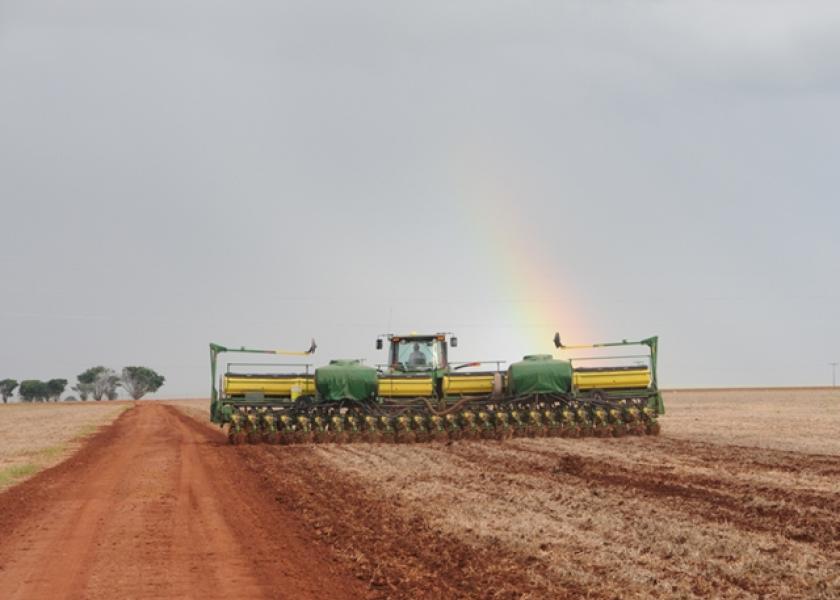Farming Flourishes Amid Brazil's Fiscal Mess

Financial and political turmoil that put Brazil on the brink of a depression also is contributing to one of the best years ever for domestic farmers.
A consequence of economic stress in Latin America’s biggest country is a weak currency that has turbo-charged export revenue for everything from soybeans to beef to coffee. Even as global surpluses spark a commodity slump, the drop in the Brazilian real against the dollar is so steep that farmers still come out ahead. Agriculture revenue will rise to a sixth straight annual record this year and grow again in 2016, the government predicts.
“That’s the only part of the economy which is still evolving positively,” said Fabio Silveira, an economist at GO Associados, a consulting firm in Sao Paulo.
The rest of Brazil is a mess. A sprawling corruption investigation has caused political gridlock in Brasilia, while the budget deficit is swelling. The economy contracted for three straight quarters, the worst since collection of the data began in 1996. Unemployment is growing, and inflation is accelerating. The longest recession since the 1930s is now mutating into “an outright economic depression,” Goldman Sachs Group Inc. said Dec. 1.
But agriculture, which accounts for 23 percent of the economy and 40 percent of exports, is still flourishing. The industry expanded 2.1 percent in the year through September, government data show, and prospects are improving after the real tumbled 29 percent this year against the dollar, the currency used for sales outside the country. A strong dollar means more reais for every ton exported. While soybean futures fell 14 percent this year in the U.S., touching the lowest since 2009, prices in reais rose 23 percent.
Agriculture Expansion
Brazil, with its vast tropical savannas and jungles, has been expanding food production for more than two decades and is the world’s largest exporter of soybeans, beef, coffee, sugar and orange juice. With the help of higher domestic prices and export sales, agriculture income will reach a record 487.3 billion reais ($128 billion) this year and rise 0.2 percent in 2016 to 488.1 billion reais, Brazil’s Ministry of Agriculture said Nov. 12.
Before the real began its slide, farmers were expected to scale back planting because of poor profit margins and low prices, said Fabio Meneghin, a partner at Florianopolis-based consulting firm Agroconsult. Since July, “the picture has completely changed,” with most crops expected to expand, he said.
Top Performers
Shares of SLC Agricola, Brazil’s largest publicly traded farming company, have risen 14 percent this year, and analysts surveyed by Bloomberg are expecting profit excluding some items to almost double next year. By comparison, the benchmark IBrX Index, a measure of top 100 equities on the Sao Paulo Stock Exchange, is down 10 percent.
“We are still in a relatively good position,” said Igor Bianco, who has seen his profit margins increase on the 25,000 acres (of soybeans and corn he farms in Lucas do Rio Verde, Mato Grosso, Brazil’s largest soybean-producing region. “We are still growing.”
Farmers now have an incentive to export as much as they can. Brazilian shipments of soybeans, the country’s biggest crop, will rise almost 12 percent to a record 57 million metric tons, the U.S. Department of Agriculture predicts. Farmers are almost done sowing the crop, which will be harvested starting in January. In the U.S., the world’s top soy grower, a stronger dollar will lead to a 7 percent drop in exports from a record the previous year, the agency said.
“The exchange rate made Brazil the most competitive producer in the world," said Pedro Dejneka, a Chicago-based analyst for AGR Brasil, a unit of AgResource Co. “The country also has plenty of grain.”
Beef, Sugar
Meat exporters also are benefiting. Beef-export sales at JBS SA’s Mercosul unit rose 9.7 percent to 2.2 billion reais in the third quarter from a year ago, as the weaker real more than offset a 11 percent drop in volumes and lower prices in dollars. Minerva SA reported that third-quarter profit, before some items, surged 56.4 percent to a record.
For Brazil’s sugar industry, the world’s largest producers, the depreciation has helped revitalize the industry. After a four-year slump caused by a global surplus, signs of tightening supply led to a rebound in prices from a seven-year low in August. Sweetener for export priced in Brazilian reais jumped 61 percent since Aug. 31 to an all-time high, more than the 40 percent gain for futures traded in New York. Over the same period, shares of producer Sao Martinho SA surged to a record, and Cosan SA gained 34 percent.
The depreciation of the real hasn’t been without its downside. The cost of imports like farm equipment and crop inputs from overseas are now far more expensive.
Sales of tractors and harvesters fell 34 percent this year to the lowest since 2007 as the government cut subsidized credit and raised interest rates to combat inflation. Deere & Co., the world’s largest farm-equipment manufacturer, said Nov. 25 that demand in South America will drop as much as 15 percent in the year that began in October. Demand for fertilizers slid 6.4 percent this year, industry data show.
Still, for those who bought new machines before this year, rising income in the domestic currency is easing real- denominated debt payments for farmers like Sergio Stefanelo, who grows corn and soybeans on 20,000 acres in Mato Grosso state. He spent about 8 million reais to acquire seven harvesters and three tractors in the past three years.
“If the currency hadn’t depreciated, it would not be viable for us to pay for those investments,” Stefanelo said by telephone from Campo Novo do Parecis.







